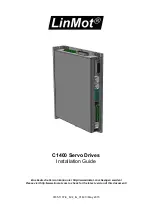
Epsilon EP-P Drive Reference Manual
159
Revision A4
www.controltechniques.com
Commutation Hardware Fault Enable
Fault.CommutationHardwareFaultEnable
When this check box is selected or this parameter is enabled, faults occurring from the commutation tracks U, V, and W will be
recognized as "E" faults in the drive. When this check box is clear, no fault will occur due to the commutation tracks. This
functionality can be useful to diagnose the nature of the "E" fault. If the check box is clear and "E" faults are still occurring, then
the encoder lines (A, A/, B, B/, C, C/) are the most likely source of the "E" fault.
Active Fault
Fault.#.Active
The specified fault is active. See the help index for more information on faults and recovery from them.
Clear Non-Critical Fault Counts
Fault.ClearNonCriticalFaultCounts
Set the value to TRUE to reset all of the module fault counts to zero. The read back value is whatever was last set (TRUE or
FALSE). It is not necessary to set it FALSE before setting it TRUE – the act of writing TRUE initiates the operation. Another
way to clear Non-Critical Fault Counts is to click on the Clear Non-Critical Fault Counts button on the Faults view/ Faults
Counts Tab when online with the drive.
Fault Counts
Fault.#.Counts
The drive stores the total number of times the specific fault has occurred since it was manufactured.
Drive OK
Fault.DriveOK
Active when there are no faults. Inactivated when any fault except travel limits occur. Drive enable has no effect on this event.
Faults Bitmap 1
Fault.FaultBitmap1
This parameter is a 32-bit register which holds drive fault status bits. Following is a list of drive faults and their associated bit
numbers:
0 = Encoder state fault
1 = Encoder hardware fault
3 = Drive power module fault
4 = Low DC bus fault
5 = High DC bus fault
8 = ISR overrun fault
9 = Drive trajectory fault
10 = Sync fault
19 = Drive over speed fault
20 = Drive invalid configuration fault
21 = Drive power up self test fault
22 = NVM Invalid fault
24 = Drive RMS shunt power fault
25 = Motor Overtemperature fault
26 = Drive Over Temp fault
30 = Auto Tune fault
All other bits are not used. A "1" in these bit locations indicates the specific fault is active, and a "0" is inactive.
Faults Bitmap 2
Fault.FaultBitmap2
This parameter is a 32-bit register holds the drive fault status bits. Following is a list of drive faults and their associated bit
numbers:
0 = Watchdog Timer fault #2
1 = Invalid Configuration fault #2
2 = NVM Invalid fault #2
3 = Power Up Test fault #2
Summary of Contents for Epsilon EP-P
Page 2: ......
Page 124: ...110 Epsilon EP P Drive Reference Manual www controltechniques com Revision A4...
Page 200: ...186 Epsilon EP P Drive Reference Manual www controltechniques com Revision A4...
Page 218: ...204 Epsilon EP P Drive Reference Manual www controltechniques com Revision A4...
Page 238: ...224 Epsilon EP P Drive Reference Manual www controltechniques com Revision A4...
Page 244: ...230 Epsilon EP P Drive Reference Manual www controltechniques com Revision A4...
Page 247: ......
















































